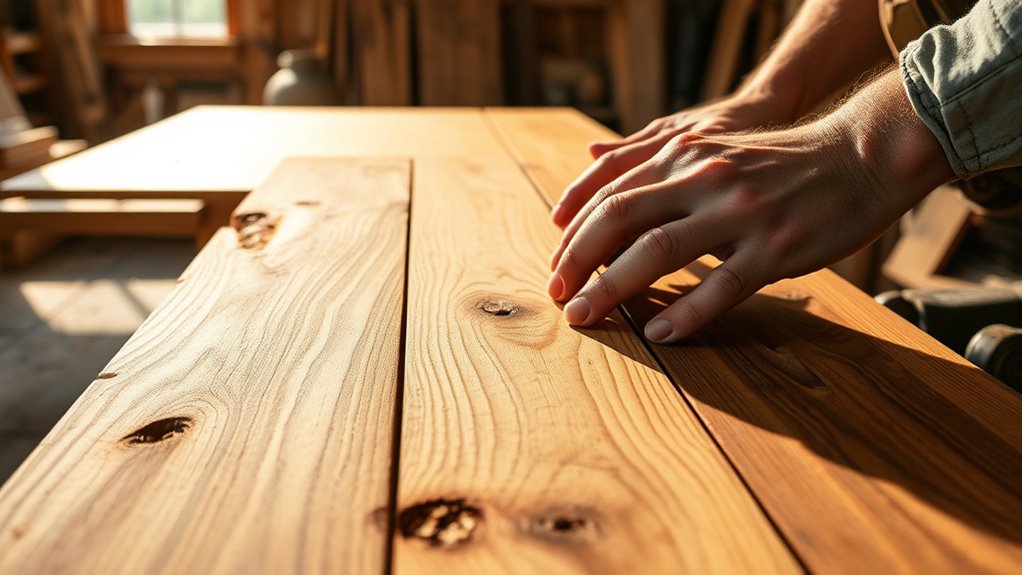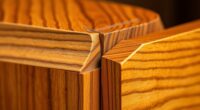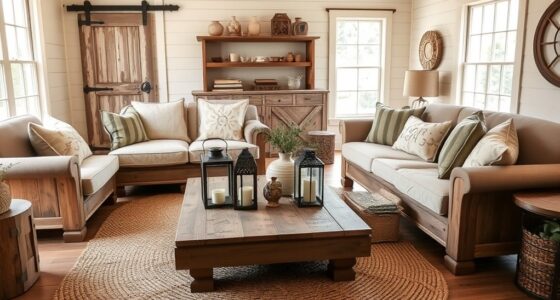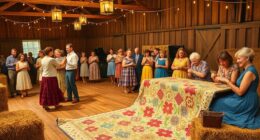To build a warp-resistant farmhouse table, choose flat-sawn, kiln-dried wood with a moisture content of 6-8%. Make certain the grain runs parallel to the length of the table for added stability, and store your wood in a consistent environment to prevent moisture fluctuations. Controlling humidity and selecting boards free from defects helps prevent warping over time. Keep these tips in mind, and uncover more secrets to a lasting, stable table as you continue.
Key Takeaways
- Choose flat-sawn lumber with consistent grain running parallel to the table’s length for stability.
- Opt for kiln-dried wood with a moisture content of 6-8% to minimize expansion and contraction.
- Acclimate wood in the environment where the table will be used for at least a week before construction.
- Select boards free from defects and with predictable movement characteristics to ensure durability.
- Store and finish wood in stable humidity conditions to prevent uneven moisture loss and warping over time.
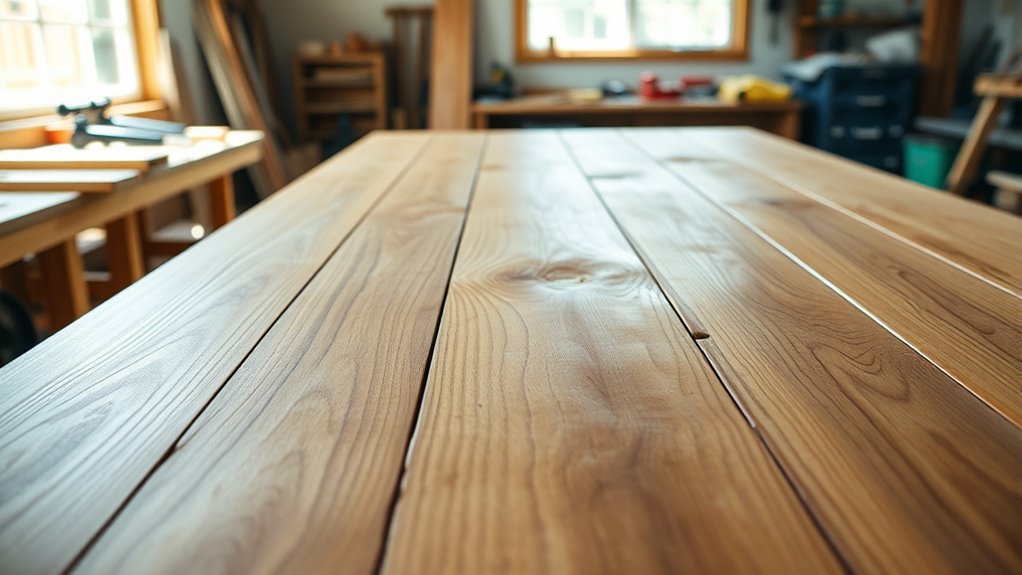
Building a farmhouse table that won’t warp requires careful planning and the right materials. One of the most critical factors is choosing the right type of wood and understanding how grain orientation influences stability. Grain orientation refers to the direction in which the wood fibers run, and it plays a significant role in how the wood responds to changes in moisture and temperature. When selecting your wood, opt for boards that are flat-sawn rather than quarter-sawn, as flat-sawn lumber tends to have more predictable movement and less tendency to warp over time. Additionally, always check the grain direction to ensure it runs parallel to the length of the table, providing added strength and reducing the risk of warping.
Choose flat-sawn wood and align grain parallel to the table’s length for lasting stability and reduced warping.
Moisture control is equally crucial in preventing warping. Wood is hygroscopic, meaning it absorbs and releases moisture depending on the environment, which causes it to expand and contract. If you don’t control moisture levels during the selection and construction process, your table could develop cracks, twists, or bows. Before you start building, ensure the wood has been properly dried and acclimated to your workshop’s humidity levels. Ideally, use kiln-dried lumber with a moisture content of around 6-8%. This minimizes the chances of expansion and contraction after your table is assembled. Keep in mind that environmental factors such as seasonal humidity changes can also impact your finished piece, so consider placing your table in a stable environment with consistent humidity levels.
To maintain moisture balance, store your wood in the same environment where the table will ultimately be used for at least a week before working with it. This helps the wood reach equilibrium with the ambient conditions, reducing surprises down the line. During construction, avoid exposing your wood to rapid temperature swings or excessive dryness, which can cause uneven moisture loss and lead to warping. When gluing or finishing, ensure the wood is at the proper moisture content to prevent the glue from weakening or the finish from cracking as the wood continues to adapt to its surroundings.
Understanding the science behind wood behavior and taking steps to mitigate those factors can greatly increase the durability of your table. Incorporating these principles—paying close attention to grain orientation and maintaining strict moisture control—sets the foundation for a durable, warp-resistant farmhouse table. By understanding how wood behaves and taking steps to mitigate those factors, you’re more likely to craft a piece that remains beautiful and stable for years to come. Your careful planning now will save you time, effort, and frustration later, resulting in a table that can withstand daily use without warping or splitting.
Frequently Asked Questions
How Does Climate Affect Wood Warping Over Time?
Climate profoundly impacts how wood warps over time. You need to maintain proper climate control and moisture regulation in your space to prevent warping. Fluctuations in humidity and temperature cause wood to expand or contract, leading to warping or cracking. By keeping the environment stable, you help guarantee your wood stays flat and durable. Regularly monitor and adjust your climate control systems to protect your furniture and woodworking projects from moisture-related issues.
What Specific Finishes Help Prevent Warping?
You want your table to stay flat, so choosing the right finish is key. Wood sealants and epoxy finishes create a barrier against moisture, preventing warping. Sealants penetrate the wood, locking in moisture, while epoxy coats form a hard shell that resists humidity and temperature changes. Together, they protect your table from the elements, ensuring it remains stable and beautiful for years to come.
Can I Repair Warping After the Table Is Built?
If your table starts warping, you can attempt wood repair by applying gentle heat and moisture to correct warp correction. Clamp the warped area and let it sit under pressure to straighten the wood. For stubborn warps, you might need to remove the affected part and replace it. Always sand and refinish after repair to restore the table’s appearance. Regular maintenance helps prevent future warp issues.
How Do I Store Wood to Avoid Warping Before Construction?
To avoid warping before construction, you need to control moisture and maintain proper storage conditions. Store your wood in a dry, covered area with good ventilation to prevent excess humidity. Keep the wood flat and off the ground using supports or pallets, and avoid drastic temperature changes. Regularly check moisture levels with a meter, ensuring the wood stays stable and ready for your project, reducing the risk of warping later.
Are Certain Wood Grains More Resistant to Warping?
Certain wood grains are more resistant to warping. You should look for straight, tight grain patterns, as they provide stability and reduce movement over time. Denser woods like oak, maple, or cherry are generally more resistant because their high wood density limits expansion and contraction. Avoid woods with irregular or wavy grain patterns, which are prone to warping. Choosing the right grain and density helps make sure your farmhouse table stays flat and sturdy.
Conclusion
Don’t let the fear of warping hold you back. With the right wood selection and proper techniques, your farmhouse table will stay beautiful and sturdy for years to come. I know it’s tempting to think it’s too complicated, but trust me—your effort will pay off. Imagine hosting family dinners around a table that’s as solid as your love for creating it. You’ve got this—your perfect table is just a few steps away.

